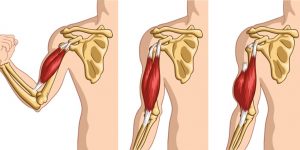Biceps Tendon Tear
Do You Experience Loss of Strength when Bending your Arm?
If so, a biceps tendon tear may be responsible.

A biceps tendon tear is a tear of one of the three tendons that connect the biceps to the shoulder and elbow. The tear can be either partial or complete. The biceps allows for bending and rotating the arm. If the biceps tendon is torn, the arm may be more or less dysfunctional.
Long & Short Biceps Tendon
The long biceps tendon originates in the shoulder joint and is located with the biceps tendon anchor at the upper rim of the glenoid. It runs over the humeral head into a tendon sheath, where it exits the shoulder joint. Sports-related overuse can lead to painful inflammation. Subsequently, progressive tendon damage can lead to a tear, resulting in an acute loss of strength in the arm.
The short biceps tendon originates from a bony prominence next to the shoulder joint and is rarely injured.

Are there Different Types of Biceps Tendon Tears?
Biceps tendon injuries are divided into two categories, depending on the location of the injury.
Proximal Biceps Tendon Tear
This injury occurs in the shoulder when one of the tendons is torn from its attachment points. The long head of the biceps tendon is frequently injured in this process.
Distal Biceps Tendon Tear
This injury occurs when the distal biceps tendon is torn from its attachment point at the elbow. A distal biceps tendon injury typically occurs in weightlifters or individuals who lift unusually heavy objects. This injury requires immediate surgical intervention.
Symptoms of Biceps Tendon Tear
The most common complaint with a biceps tendon tear is a sharp, sudden pain at the site of the tear.
Other symptoms include:
- Weakness in the shoulder or elbow
- Popping sound at the time of the tear
- Bruising on the upper arm or elbow
- Cramping of the upper arm when using the biceps muscle
- Difficulty rotating the forearm
- “Popeye muscle“: Since the tendon no longer holds the biceps muscle taut, a bulge may form along the front of the upper arm
Diagnosis of Biceps Tendon Tear
Damage to the long biceps tendon is primarily diagnosed clinically. Imaging is performed using ultrasound and/or magnetic resonance imaging.
Therapy for Biceps Tendon Tear
Inflammation is treated conservatively, i.e., without surgery. Physiotherapy and anti-inflammatory medications provide relief.
If a partial or complete tear is present, a surgical procedure should be chosen, depending on the patient’s athletic activity.
Biceps Tenodesis Surgery
In this operation, the torn tendon is shortened around the damaged portion and fixed to the humeral head with a special bone anchor. This restores arm flexion function and reduces pain. The operation is performed arthroscopically minimally invasive using a “keyhole technique.”
Post-treatment for Biceps Tendon Tear
After the operation, patients remain in inpatient care for 2-3 days.
If the biceps tendon is only cut, the affected arm is only briefly immobilized after the operation, and physiotherapy can begin immediately. If the long biceps tendon or the biceps tendon anchor is re-attached, the shoulder is immobilized for 4 weeks. Physiotherapy then follows.

Dr. Mark Schurz
CONTACT